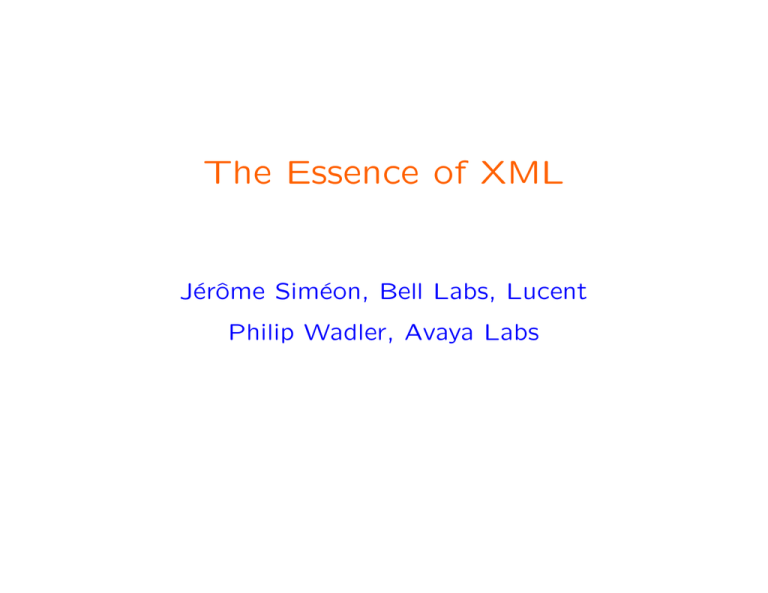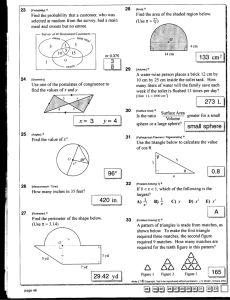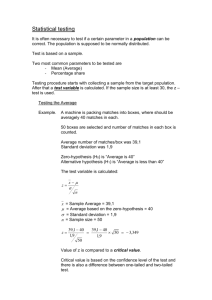The Essence of XML J´ erˆ ome Sim´
advertisement

The Essence of XML
Jérôme Siméon, Bell Labs, Lucent
Philip Wadler, Avaya Labs
The Evolution of Language
2x
(Descartes)
λx. 2x
(Church)
(LAMBDA (X) (* 2 X))
(McCarthy)
<?xml version="1.0"?>
<LAMBDA-TERM>
<VAR-LIST>
<VAR>X</VAR>
</VAR-LIST>
<EXPR>
<APPLICATION>
<EXPR><CONST>*</CONST></EXPR>
<ARGUMENT-LIST>
<EXPR><CONST>2</CONST></EXPR>
<EXPR><VAR>X</VAR></EXPR>
</ARGUMENT-LIST>
</APPLICATION>
</EXPR>
</LAMBDA-TERM>
(W3C)
XML everywhere!
The Essence of XML
XML vs. S-expressions
<foo>1 2 3</foo>
(foo ”1 2 3”)
(foo 1 2 3)
<bar>1 two 3</bar>
(bar 1 ”two” 3)
(bar 1 ”two” ”3”)
XML Schema and Validation
<foo>1 2 3</foo>
⇓
element foo of type integer-list { 1, 2, 3 }
⇓
<foo>1 2 3</foo>
<xs:simpleType name=”integer-list”>
<xs:list itemType=”xs:integer”/>
</xs:simpleType>
<xs:element name=”foo” type=”integer-list”/>
Mixing it up
<bar>1 two 3</bar>
⇓
element bar of type mixed-list { 1, ”two”, 3 }
⇓
<bar>1 two 3</bar>
<xs:simpleType name=”mixed-list”>
<xs:list>
<xs:union memberTypes=”xs:integer xs:string”/>
</xs:list>
</xs:simpleType>
<xs:element name=”bar” type=”mixed-list”/>
Really mixing it up
element bar of type mixed-list { 1, ”two”, ”3” }
⇓
<bar>1 two 3</bar>
⇓
element bar of type mixed-list { 1, ”two”, 3 }
<xs:simpleType name=”mixed-list”>
<xs:list>
<xs:union memberTypes=”xs:integer xs:string”/>
</xs:list>
</xs:simpleType>
<xs:element name=”bar” type=”mixed-list”/>
The Essence of XML
• The problem it solves is not hard.
• It doesn’t solve it very well.
The Essence of XML
• The problem it solves is not hard.
• It doesn’t solve it very well.
• (Not entirely fair:
XML is based on SGML, which was aimed at documents, not
data)
• (NB. “Essence” is used in the same sense as
Reynolds “The Essence of Algol”
Harper and Mitchell “The Essence of ML”
Wadler “The Essence of Functional Programming”)
Our contribution
• XML and Schema are in widespread use,
so worth some effort to model.
• We give a foundational theory.
• Validation differs from matching.
• We characterize validation with a theorem.
• Simple version in paper,
less simple in XQuery formal semantics.
What’s in a name?
Structural types vs. Named types
type Feet = Integer
type Miles = Integer
• Structural: two names for the same thing
• Named: two distinct types
Named typing and strategic defense
enter height?
10023
Named typing and strategic defense
enter height?
10023
Named typing and strategic defense
enter height?
10023
Schema and XQuery
XML Schema
<xs:simpleType name=”integer-list”>
<xs:list itemType=”xs:integer”/>
</xs:simpleType>
<xs:element name=”foo” type=”integer-list”/>
<xs:simpleType name=”mixed-list”>
<xs:list>
<xs:union memberTypes=”xs:integer xs:string”/>
</xs:list>
</xs:simpleType>
<xs:element name=”bar” type=”integer-list”/>
XQuery
define type integer-list { xs:integer* }
define element foo of type integer-list
define type mixed-list { (xs:integer|xs:string)* }
define element bar of type mixed-list
Schema
<xs:simpleType name=”feet”>
<xs:restriction base=”xs:integer”/>
</xs:simpleType>
<xs:simpleType name=”miles”>
<xs:restriction base=”xs:integer”/>
</xs:simpleType>
<xs:element name=”configuration”>
<xs:complexType>
<xs:sequence>
<xs:element name=”shuttle” type=”miles”/>
<xs:element name=”laser” type=”feet”/>
</xs:sequence>
</xs:complexType>
</xs:element>
XQuery
define type feet restricts xs:integer
define type miles restricts xs:integer
define element configuration of type configuration.type
define type configuration.type {
element shuttle of type feet,
element laser of type miles
}
Validation, Matching, and Erasure
Data model
<configuration>
<shuttle>120</shuttle>
<laser>10023</laser>
</configuration>
=
element configuration {
element shuttle { ”120” },
element laser { ”10023” }
}
Validation
validate as Type { UntypedValue } ⇒ Value
validate as element configuration {
element configuration {
element shuttle { ”120” },
element laser { ”10023” }
}
} ⇒
element configuration of type configuration.type {
element shuttle of type miles { 120 },
element laser of type feet { 10023 }
}
Matching
Value matches Type
element configuration of type configuration.type {
element shuttle of type miles { 120 },
element laser of type feet { 10023 }
}
matches
element configuration of type configuration.type
Matching depends on type names
Value matches Type
element configuration of type configuration.type {
element shuttle of type miles { 120 },
element laser of type miles { 10023 }
}
matches
element configuration of type configuration.type
(not!)
Unvalidated data does not match
element configuration {
element shuttle { ”120” },
element laser { ”10023” }
}
matches
element configuration of type configuration.type
(not!)
Erasure
Value erases to UntypedValue
element configuration of type configuration.type {
element shuttle of type miles { 120 },
element laser of type feet { 10023 }
}
erases to
element configuration {
element shuttle { ”120” },
element laser { ”10023” }
}
Erasure is a relation
validate as xs:integer ( ”7” ) ⇒ 7
validate as xs:integer ( ”007” ) ⇒ 7
7 erases to ”7”
7 erases to ”007”
Inference rules
Matching: Sequence and choice
() matches ()
Value 1 matches Type 1
Value 2 matches Type 2
Value 1 , Value 2 matches Type 1 , Type 2
Value matches Type 1
Value matches Type 1 | Type 2
Value matches Type 2
Value matches Type 1 | Type 2
Matching: Occurrence and base types
Value matches () | Type
Value matches Type ?
Value matches Type , Type *
Value matches Type +
Value matches Type + ?
Value matches Type *
AtomicTypeName derives from xs:string
String matches AtomicTypeName
AtomicTypeName derives from xs:integer
Integer matches AtomicTypeName
Matching: Element
ElementType
yields BaseElementName of type BaseTypeName
BaseTypeName resolves to Type
ElementName substitutes for BaseElementName
TypeName derives from BaseTypeName
Value matches Type
element ElementName of type TypeName { Value }
matches ElementType
Validation: Element
ElementType
yields BaseElementName of type BaseTypeName
BaseTypeName resolves to Type
ElementName substitutes for BaseElementName
validate as Type { UntypedValue } ⇒ Value
validate as ElementType {
element ElementName { UntypedValue }
} ⇒ element ElementName of type TypeName { Value }
The validation theorem
The validation theorem
Theorem We have that
validate as Type { UntypedValue } ⇒ Value
if and only if
Value matches Type
Value erases to UntypedValue.
• Obvious in retrospect, not so obvious in prospect.
• Trick is to make validation and erasure into relations.
Ambiguity and Roundtripping
Definition The type Type is unambiguous for validation if for
every UntypedValue there is at most one Value such that
validate as Type { UntypedValue } ⇒ Value.
Corollary (Roundtripping) If
Value matches Type
Value erases to UntypedValue
validate as Type { UntypedValue } ⇒ Value 0
Type is unambiguous for validation
then
Value = Value 0.
Example: An unambiguous type
element foo of type integer-list { 1, 2, 3 }
erases to
<foo>1 2 3</foo>
validate as element foo {
<foo>1 2 3</foo>
} ⇒
element foo of type integer-list { 1, 2, 3 }
Example: An ambiguous type
element bar of type mixed-list { ”1”, ”two”, ”3” }
erases to
<bar>1 two 3</bar>
validate as element bar {
<bar>1 two 3</bar>
} ⇒
element bar of type mixed-list { 1, ”two”, 3 }
Conclusions
The Essence of XML
• Validation
validate as Type { UntypedValue } ⇒ Value
• Matching
Value matches Type
• Erasure
Value erases to UntypedValue
• Validation Theorem
Theorem We have that
validate as Type { UntypedValue } ⇒ Value
if and only if
Value matches Type
Value erases to UntypedValue.
XQuery formal semantics (not in paper)
• Dynamic Semantics
DynEnv ` Expr ⇒ Value
• Static Semantics
StatEnv ` Expr : Type
• Type Soundness
Theorem If
DynEnv ` Expr ⇒ Value
StatEnv ` Expr : Type
then
Value matches Type.
Success stories
• XQuery has two specifications, one in prose and one using
formal methods — one of the first uses of formal methods
in an industrial standard.
• Formalization of named typing raised ten issues not resolved
in the prose specification.
• XQuery face-to-face, Chapel Hill, NC, 17–18 October 2002:
After presentation of formal semantics of pure named typing,
it was accepted without dissent. In the two-day meeting, this
was the only decision adopted without dissent.
• Our techniques also adopted by James Clark and Makoto
Murata to formalize Relax NG, another industrial standard.
Action items
• Paper in POPL proceedings misprinted; get it from the web.
• Review XQuery and send us your comments!



